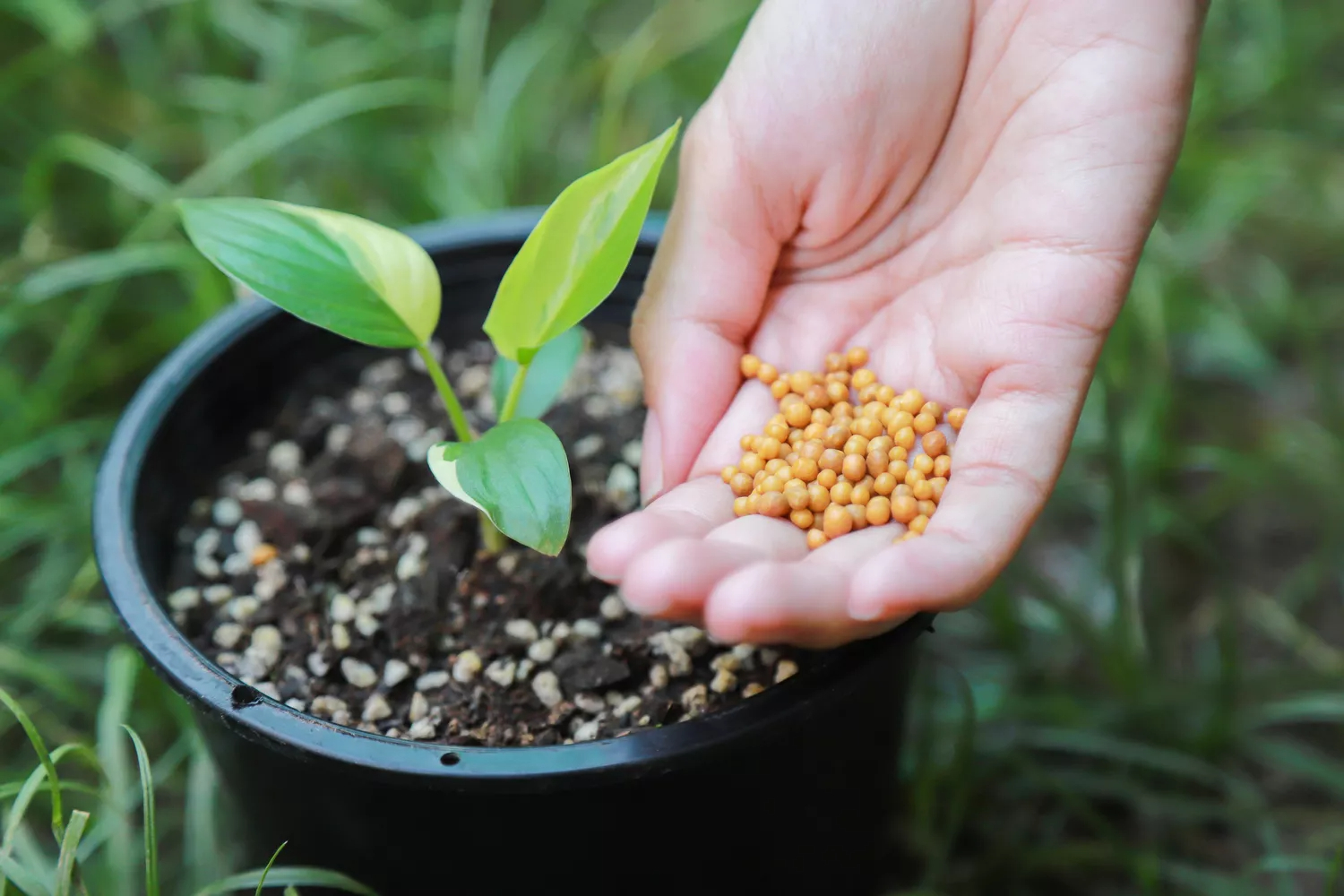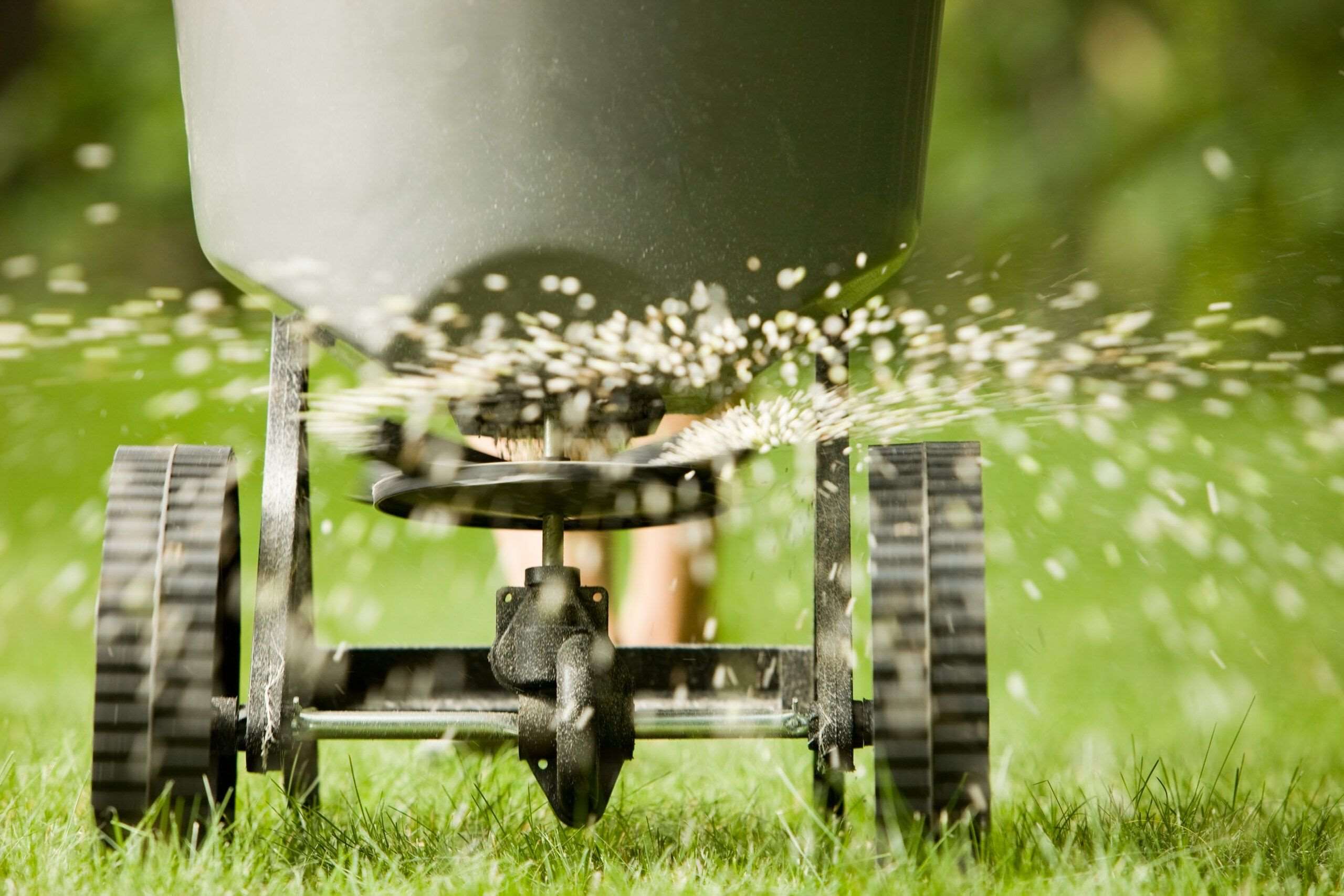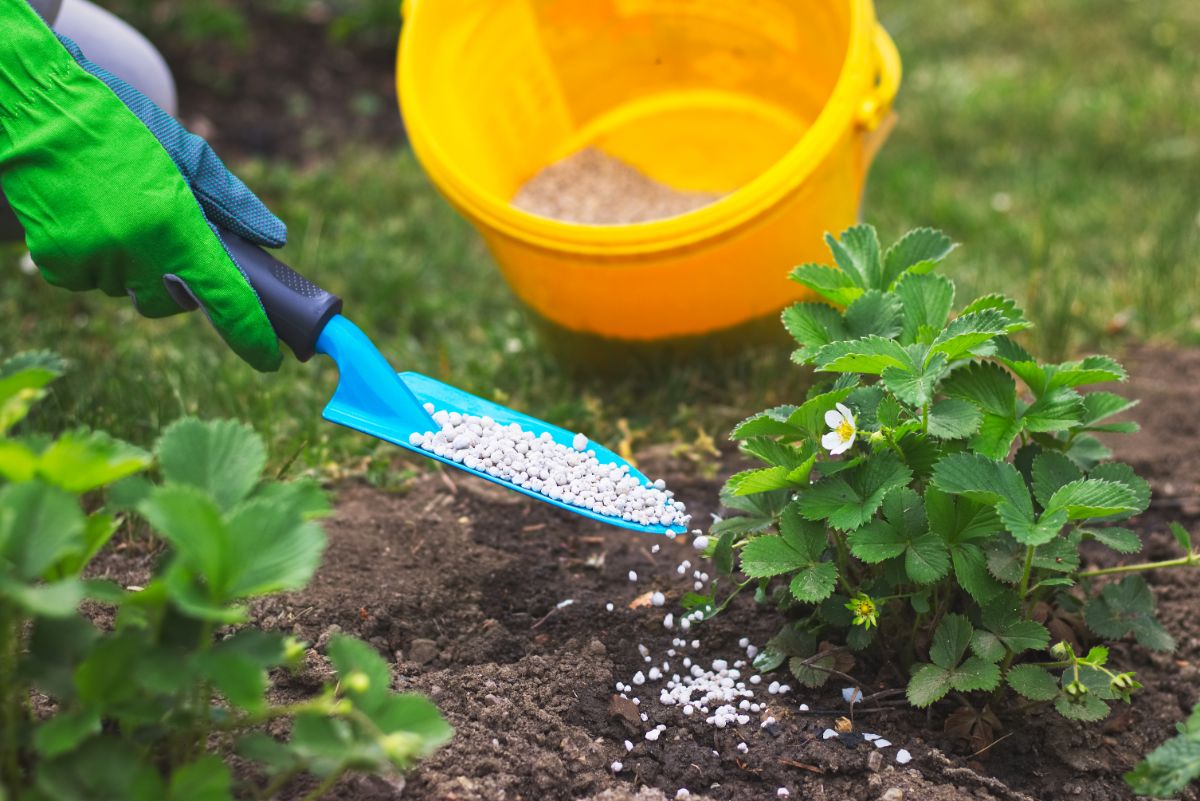Home>Articles>What Type Of Fertilizer Is Best For Your Garden?


Articles
What Type Of Fertilizer Is Best For Your Garden?
Modified: October 20, 2024
Discover the best articles on different types of fertilizer and learn how to choose the right one for your plants. Enhance your gardening knowledge with expert advice and tips.
(Many of the links in this article redirect to a specific reviewed product. Your purchase of these products through affiliate links helps to generate commission for Storables.com, at no extra cost. Learn more)
Introduction
Welcome to the world of fertilizers! If you are a gardener, a farmer, or have any interest in plants and crops, then you are likely familiar with the importance of fertilizers. Fertilizers play a crucial role in ensuring the healthy growth and development of plants by providing essential nutrients that may be lacking in the soil.
In this article, we will explore the different types of fertilizers available in the market and understand their specific roles in plant nutrition. From organic fertilizers to inorganic options, we’ll dive into the varieties of fertilizers that can help you achieve optimal plant health and yield.
Whether you are a seasoned gardener or just starting out, understanding the different types of fertilizers will empower you to make informed decisions regarding your plants’ nutrition and overall well-being. So, let’s dig in and explore the fascinating world of fertilizers!
Key Takeaways:
- Understanding the different types of fertilizers, from organic to inorganic, empowers plant enthusiasts to make informed decisions for optimal plant health and productivity. It’s crucial to consider nutrient requirements, soil analysis, and environmental impact when choosing the right fertilizer.
- Nitrogen, phosphorus, potassium, and micronutrient fertilizers play vital roles in promoting plant growth and development. By carefully selecting and responsibly using fertilizers, individuals can ensure the well-being of their beloved plants while fostering a sustainable and productive growing environment.
Importance of Fertilizer
Fertilizers are vital for plant growth and nourishment. They provide essential nutrients that are necessary for plant health, development, and productivity. Even the most fertile soils may lack certain nutrients required by plants, and that is where fertilizers come into play.
The primary nutrients that plants require for healthy growth are nitrogen (N), phosphorus (P), and potassium (K), commonly referred to as NPK. These nutrients play different roles in plant development. Nitrogen is crucial for foliage growth, phosphorus aids in root development and flower formation, and potassium promotes overall plant health and disease resistance.
In addition to the primary nutrients, plants also require secondary nutrients and trace elements known as micronutrients. These include calcium, magnesium, iron, zinc, and others in small quantities. While these nutrients are needed in smaller amounts compared to the primary nutrients, their deficiency can have a significant impact on plant growth and productivity.
Fertilizers help replenish the nutrients in the soil, ensuring that plants have access to the necessary elements for their growth. They assist in maintaining optimal nutrient levels in the soil, especially in areas where the natural soil composition may not provide adequate nutrition for plants.
Proper fertilization improves the quality and quantity of agricultural crops, enhancing yield and reducing wastage. In the garden, fertilizers help plants establish stronger roots, produce more vibrant flowers, and yield healthier fruits and vegetables. They also play a crucial role in rejuvenating tired or nutrient-depleted soils, promoting a sustainable and productive growing environment.
However, it’s important to note that while fertilizers provide essential nutrients, their misuse or overuse can have negative effects. Excessive fertilizer application can lead to nutrient imbalances, environmental pollution, and damage to plants and beneficial soil organisms. It is crucial to follow recommended application rates and guidelines to ensure efficient and responsible fertilizer usage.
Now that we understand the importance of fertilizers let’s explore the two main types: organic and inorganic fertilizers, and their respective roles in plant nutrition.
Organic Fertilizers
Organic fertilizers are derived from natural sources and are a popular choice for many gardeners and farmers who prioritize sustainability and environmental friendliness. These fertilizers are made from plant and animal byproducts, such as compost, manure, bone meal, and fish emulsion.
One of the key benefits of organic fertilizers is their ability to improve the soil structure. They help increase the water-holding capacity of the soil, promote beneficial microbial activity, and enhance overall soil fertility. Organic fertilizers slowly release nutrients into the soil, providing a continuous source of nourishment for plants over an extended period.
In addition to providing essential nutrients, organic fertilizers also improve soil health. They work hand in hand with the soil ecosystem, encouraging the growth of beneficial microorganisms and earthworms, which in turn enhance nutrient availability and nutrient cycling in the soil.
Another advantage of organic fertilizers is their low risk of nutrient burning or toxic buildup in the soil. Unlike some inorganic fertilizers, organic alternatives release nutrients gradually, reducing the risk of over-fertilization and subsequent harm to plants.
While organic fertilizers offer several benefits, they do have some limitations. The nutrient content of organic fertilizers can vary, making it crucial to choose high-quality products. They may also take longer to show visible results compared to synthetic fertilizers, as they rely on microbes and natural processes to release nutrients into the soil.
However, the long-term benefits of organic fertilizers often outweigh these drawbacks. By improving soil structure, enhancing biodiversity, and fostering sustainable agricultural practices, organic fertilizers contribute to the overall health and vitality of both plants and the environment.
Now, let’s explore inorganic fertilizers, which are widely used due to their immediate availability and precise nutrient content.
Inorganic Fertilizers
Inorganic fertilizers, also known as synthetic or chemical fertilizers, are manufactured using synthetic compounds rather than natural sources. These fertilizers are formulated to contain specific ratios of essential nutrients, making them highly customizable and effective in addressing nutrient deficiencies.
One of the main advantages of inorganic fertilizers is their immediate availability. Since the nutrients in these fertilizers are in a readily soluble form, they can be quickly absorbed by plant roots, providing an instant boost of nutrition. This rapid nutrient uptake can be especially beneficial during periods of high plant demand or when addressing acute nutrient deficiencies.
Inorganic fertilizers offer precise control over nutrient ratios, allowing farmers and gardeners to tailor the fertilization program to specific plant requirements. They can be formulated to provide a targeted balance of nitrogen, phosphorus, and potassium, depending on the specific needs of the plants being cultivated. This customization is particularly valuable for commercial agriculture, where maximizing yields and crop quality is a priority.
Furthermore, inorganic fertilizers can be manufactured to contain specific micronutrients, ensuring that plants receive all essential elements for optimal growth. This targeted nutrient delivery creates conditions that are ideal for plant development, improving crop yields and quality.
However, it is important to note that inorganic fertilizers have their drawbacks as well. Due to their high solubility, excess fertilization or improper application can lead to nutrient runoff, which can pollute water bodies and cause environmental harm. Additionally, the overuse of inorganic fertilizers can result in soil acidification, nutrient imbalances, and reduced soil microbial activity.
While inorganic fertilizers provide an immediate nutrient supply and precise nutrient control, they should be used judiciously, adhering to recommended application rates and considering their potential environmental impact. Combining the use of inorganic fertilizers with organic amendments can create a balanced approach that promotes both plant health and environmental sustainability.
Now that we have explored organic and inorganic fertilizers, let’s take a closer look at the specific types of fertilizers based on their primary nutrient content.
Nitrogen-based Fertilizers
Nitrogen is an essential nutrient for plant growth and plays a crucial role in the production of proteins, chlorophyll, and enzymes. It is responsible for promoting vigorous leaf and stem growth, as well as enhancing overall plant health. Nitrogen-based fertilizers are designed to provide a concentrated source of nitrogen to plants.
There are several common types of nitrogen-based fertilizers available in the market, including ammonium nitrate, urea, ammonium sulfate, and calcium nitrate. These fertilizers supply nitrogen in different forms, offering various benefits depending on the specific application.
Ammonium nitrate is a widely used nitrogen fertilizer that contains both ammonium and nitrate forms of nitrogen. It is highly soluble and provides readily available nitrogen that can be quickly absorbed by plant roots. Ammonium nitrate is commonly used in agriculture to promote rapid growth and increase crop yields. However, due to its potential for explosive reactions, it is subject to strict handling and storage regulations.
Urea is another popular nitrogen fertilizer that is cost-effective and contains a high concentration of nitrogen. It is a versatile fertilizer that can be used for both soil application and foliar spraying. Urea requires enzymatic conversion by soil bacteria to be utilized by plants, making it a slower-releasing nitrogen source. This slow release helps ensure a sustained supply of nitrogen to plants over a longer period of time.
Ammonium sulfate is a nitrogen fertilizer that also provides a source of sulfur, which is another important nutrient for plant growth. It is highly soluble and quickly releases nitrogen for plant uptake. Ammonium sulfate is commonly used in alkaline soils or when there is a sulfur deficiency, as it helps lower soil pH and supplies both nitrogen and sulfur to plants.
Calcium nitrate is a nitrogen fertilizer that also contains calcium, an essential nutrient for cell wall structure and overall plant development. It provides a readily available form of nitrogen that is absorbed by plants and improves calcium availability in the soil. Calcium nitrate is often used in hydroponic systems and for foliar application, as it can be easily taken up by plants through the leaves.
When using nitrogen-based fertilizers, it is important to follow recommended application rates and timing. Nitrogen is mobile in the soil and can be easily leached away by excessive rainfall or irrigation if not uptaken by plants promptly. This can lead to nutrient loss and environmental pollution. Proper management of nitrogen-based fertilizers is essential to maximize their effectiveness while minimizing negative impacts.
Now that we have explored the nitrogen-based fertilizers, let’s move on to the next primary nutrient – phosphorus, and its role in plant nutrition.
When choosing a fertilizer, consider the specific needs of your plants. Look for a balanced NPK ratio (nitrogen, phosphorus, potassium) and consider organic options for long-term soil health.
Phosphorus-based Fertilizers
Phosphorus is a vital nutrient for plant growth and development. It plays a crucial role in energy transfer, root development, flowering, and fruiting. Phosphorus-based fertilizers are specifically formulated to provide plants with a concentrated source of phosphorus.
There are different types of phosphorus-based fertilizers available, each with its own characteristics and benefits. These fertilizers typically contain phosphorus in the form of phosphate compounds, such as monoammonium phosphate (MAP), diammonium phosphate (DAP), and triple superphosphate (TSP).
MAP is a popular phosphorus-based fertilizer that contains both ammonium and phosphate. It is highly soluble and provides readily available phosphorus to plants. The ammonium component helps acidify the soil, making it suitable for alkaline or high-pH soils. MAP is commonly used at the time of planting or during early growth stages to promote strong root development and improve overall plant vigor.
DAP is another commonly used phosphorus-based fertilizer that contains both ammonium and phosphate forms of phosphorus. It is versatile and can be applied to various crops and in different soil types. DAP provides an immediate supply of phosphorus to plants, promoting early root development and enhancing flower and fruit production. Due to its high nutrient content, DAP is often favored for crops with high phosphorus requirements.
TSP, or triple superphosphate, is a highly concentrated phosphorus fertilizer that contains a high percentage of available phosphorus. It is created by treating rock phosphate with sulfuric acid to make the phosphorus more soluble. TSP releases phosphorus gradually, providing a sustained supply of this essential nutrient to plants over time. It is commonly used in situations where a slow-release phosphorus source is desired, such as in perennial crops or in areas with low phosphorus availability in the soil.
When applying phosphorus-based fertilizers, it is important to consider the soil pH and phosphorus requirements of the specific plants. Phosphorus availability in the soil can be affected by soil pH, with lower pH levels facilitating better phosphorus uptake. Additionally, phosphorus runoff can contribute to water pollution, so it is essential to apply these fertilizers responsibly, following recommended rates and timing.
Now that we have covered phosphorus-based fertilizers, let’s move on to the final primary nutrient – potassium, and its role in plant nutrition.
Potassium-based Fertilizers
Potassium is an essential nutrient for plant growth and development. It plays a vital role in various physiological processes, including photosynthesis, water regulation, nutrient transport, and enzyme activation. Potassium-based fertilizers are designed to provide plants with a concentrated source of potassium.
There are different types of potassium-based fertilizers available, each with its own characteristics and benefits. These fertilizers typically contain potassium in the form of water-soluble compounds, such as potassium chloride (KCl), potassium sulfate (K2SO4), and potassium nitrate (KNO3).
Potassium chloride, often referred to as muriate of potash (MOP), is the most commonly used potassium-based fertilizer. It contains a high percentage of potassium and is cost-effective. Potassium chloride is readily soluble and provides an immediate supply of potassium to plants. It is commonly used in agriculture to promote overall plant health, improve water regulation, enhance drought resistance, and increase fruit quality and yield.
Potassium sulfate is another potassium-based fertilizer that contains both potassium and sulfur. It provides a good source of potassium for plants while also addressing sulfur deficiencies. Potassium sulfate is often preferred for crops that require both nutrients, such as fruits, vegetables, and horticultural plants. It is also suitable for crops grown in soils with high pH levels that may inhibit potassium uptake.
Potassium nitrate is a water-soluble potassium fertilizer that also contains nitrogen in the form of nitrate. It provides a readily available source of potassium and nitrogen, making it an ideal choice for plants with high potassium requirements, such as fruit-bearing trees and crops. Potassium nitrate is commonly used in fertigation systems, where it can be easily dissolved and distributed through irrigation water.
When applying potassium-based fertilizers, it is important to consider the specific requirements of the plants and the soil conditions. Potassium availability can be influenced by factors such as soil pH, cation exchange capacity, and nutrient interactions. Additionally, excessive application of potassium can lead to imbalances with other nutrients and can impact soil pH, so it is important to follow recommended rates and monitor soil nutrient levels.
Now that we have covered potassium-based fertilizers, let’s move on to the final category – micronutrient fertilizers.
Micronutrient Fertilizers
While plants require nutrients in varying quantities, there are some elements that are essential in only small amounts but are crucial for their growth and development. These elements are known as micronutrients. Micronutrient fertilizers are formulated to provide plants with these essential trace elements.
Some common micronutrients include iron, zinc, manganese, copper, molybdenum, and boron. These elements play specific roles in plant metabolism, enzyme activation, and overall growth regulation.
Iron is essential for chlorophyll production and plays a critical role in photosynthesis. Iron deficiency results in yellowing of leaves, known as chlorosis. Iron chelates, such as iron EDTA or iron EDDHA, are commonly used as micronutrient fertilizers to address iron deficiencies in plants.
Zinc is involved in various enzymatic processes and is important for hormone synthesis and protein production. Zinc deficiency can lead to stunted growth and poor fruit development. Zinc sulfate is a widely used zinc fertilizer that helps correct zinc deficiencies in plants.
Manganese is essential for chlorophyll synthesis and enzyme activation. Manganese deficiency can result in yellowing and mottling of leaves. Manganese sulfate and manganese chelates are commonly used as micronutrient fertilizers to provide plants with an adequate supply of manganese.
Copper plays a crucial role in enzyme activation and electron transport within the plant. Copper deficiency can lead to wilting and browning of leaves. Copper sulfate is a commonly used copper fertilizer that helps correct copper deficiencies in plants.
Molybdenum is necessary for nitrogen fixation and conversion in legume plants, as well as for enzyme activity in various metabolic processes. Sodium molybdate and ammonium molybdate are commonly used as molybdenum fertilizers to address molybdenum deficiencies in plants.
Boron is involved in cell division, carbohydrate metabolism, and pollen tube growth. Boron deficiency can result in distorted growth and poor fruit development. Boric acid, borax, and other boron compounds are commonly used as micronutrient fertilizers to provide plants with an adequate supply of boron.
Micronutrient fertilizers are available in various forms, including chelated compounds, soluble salts, and foliar sprays. The specific form and application method depend on the nutrient deficiency, plant requirements, and soil conditions.
When using micronutrient fertilizers, it is important to follow recommended rates and avoid excessive application, as micronutrients can also become toxic to plants at high concentrations. Regular soil testing can help identify micronutrient deficiencies and guide the appropriate application of micronutrient fertilizers.
Now that we have covered the different types of fertilizers, let’s move on to understanding how to choose the right fertilizer for your specific needs.
Choosing the Right Fertilizer
When it comes to choosing the right fertilizer for your plants, there are several factors to consider. Understanding your plants’ specific nutritional needs, soil conditions, and environmental factors can help you make an informed decision.
1. Nutritional requirements: Different plants have different nutrient requirements. It is important to identify the primary macro-nutrients (nitrogen, phosphorus, and potassium) that your plants need and select a fertilizer that provides them in the appropriate ratios. Additionally, consider any specific micronutrient deficiencies your plants may have and choose a fertilizer that addresses those needs.
2. Soil analysis: Conducting a soil analysis can provide valuable insights into the nutrient levels and pH of your soil. This analysis helps you identify any nutrient deficiencies or imbalances, allowing you to choose a fertilizer that specifically targets those deficiencies. It also helps determine the appropriate pH level for optimal nutrient availability.
3. Soil type: Different soil types have different nutrient-holding capacities and drainage properties. Sandy soils, for example, are often low in nutrients and require fertilizers that release nutrients slowly. On the other hand, clay soils may need fertilizers that can penetrate the dense soil particles and provide nutrients effectively.
4. Plant stage: The growth stage of your plants can influence their nutrient requirements. Young plants may benefit from a fertilizer with higher levels of phosphorus to promote strong root development, while flowering plants may require higher levels of potassium to encourage blooming and fruiting.
5. Application method: Consider the most suitable application method for your plants and the specific fertilizer. Some fertilizers are well-suited for soil application, while others may be more effective when applied as a foliar spray or through fertigation systems. Understanding the capabilities and limitations of different application methods can help ensure efficient nutrient uptake.
6. Environmental considerations: It is important to consider the environmental impact of fertilizers. Choose fertilizers that are formulated to minimize nutrient runoff and leaching, reducing the risk of water pollution. Additionally, opt for slow-release fertilizers or organic alternatives that promote long-term soil health and sustainability.
7. Budget and availability: Finally, consider your budget and the availability of fertilizers in your area. Different fertilizers vary in cost, and some may be more readily available than others. However, keep in mind that the cheapest option may not always be the most effective or suitable for your plants’ needs.
By considering these factors and understanding your plants’ requirements, you can make an informed decision when choosing the right fertilizer. Remember, regular monitoring of your plants’ response to fertilization and adjusting the application as needed is crucial for maintaining optimal plant health and productivity.
Now that we have explored how to choose the right fertilizer, let’s wrap up our discussion.
Conclusion
Fertilizers play a crucial role in providing essential nutrients to plants, ensuring their healthy growth and productivity. Understanding the different types of fertilizers and their specific roles in plant nutrition empowers gardeners, farmers, and plant enthusiasts to make informed decisions about their plant’s well-being.
Organic fertilizers, derived from natural sources, promote soil health and sustainability. They improve soil structure, enhance nutrient availability, and foster beneficial microbial activity. While organic fertilizers may take longer to show visible results, their long-term benefits outweigh the drawbacks, making them a popular choice for eco-conscious individuals.
Inorganic fertilizers, also known as synthetic or chemical fertilizers, offer immediate nutrient availability and precise nutrient control. With their customizable nutrient ratios, they provide targeted nutrition to plants, helping optimize growth and yields. However, careful application is crucial to avoid environmental impacts and nutrient imbalances.
The primary nutrients – nitrogen, phosphorus, and potassium – are essential for different aspects of plant growth, such as foliage development, root establishment, and overall plant health. Nitrogen-based fertilizers enhance leaf and stem growth, phosphorus-based fertilizers promote root development and flowering, and potassium-based fertilizers improve cellular functioning and water regulation.
Micronutrient fertilizers address the trace element needs of plants, ensuring optimal metabolic processes and overall growth. These micronutrients, such as iron, zinc, manganese, copper, molybdenum, and boron, play critical roles in enzyme activation, photosynthesis, and hormone synthesis.
Choosing the right fertilizer involves considering factors such as nutritional requirements, soil analysis, soil type, plant stage, application method, environmental impact, and budget. An informed decision ensures that plants receive the appropriate nutrients at the right time and in the right form, promoting their health, vitality, and productivity.
Remember, responsible fertilizer usage is key. Following recommended rates, conducting regular soil tests, and monitoring plants’ response to fertilization helps maintain adequate nutrient levels, prevents nutrient imbalances, and reduces environmental risks.
So whether you’re tending to a garden, cultivating crops, or simply caring for your houseplants, understanding the world of fertilizers empowers you to provide optimal nutrition to your beloved green companions. With the right fertilizer, you can foster healthy, vibrant, and thriving plants that bring joy and beauty to your surroundings.
Happy fertilizing!
Frequently Asked Questions about What Type Of Fertilizer Is Best For Your Garden?
Was this page helpful?
At Storables.com, we guarantee accurate and reliable information. Our content, validated by Expert Board Contributors, is crafted following stringent Editorial Policies. We're committed to providing you with well-researched, expert-backed insights for all your informational needs.














0 thoughts on “What Type Of Fertilizer Is Best For Your Garden?”